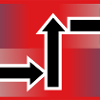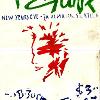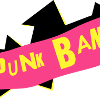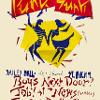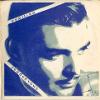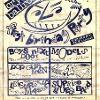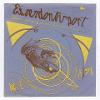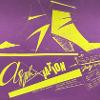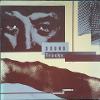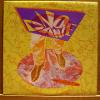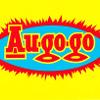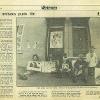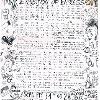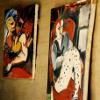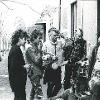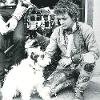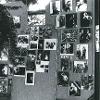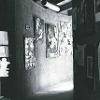'Art-punk' refers to punk music with an experimental bent, or with connections to art school, the art world, or the avant-garde. The New York Dolls, Television, Patti Smith, Devo, Talking Heads and Wire have all been described as Art-punk bands, while even the Sex Pistols played their first gig in 1975 at Saint Martin's School of Art in London.
In the mid to late 70s, at the height of the punk scene, a strong intersection between punk music and art was being formed right here in Melbourne. At venues like the Tiger Lounge in Richmond, Bananas and the Crystal Ballroom in St Kilda, the Champion Hotel in Fitzroy and the Exford Hotel in the CBD, punk musicians and young visual artists were feeding off each other's creative energy, and fusing what would ultimately become a new subcultural language.
Art schools like the Caulfield Institute of Technology, the National Gallery Art School (later to become the Victorian College of the Arts), the Prahran College of Advanced Education and the Royal Institute of Technology (RMIT) were turning out visual artists such as Jenny Watson, Howard Arkley, Jon Cattapan, David Larwill, Pasquale Giordano and John Nixon, and along with artists-cum-musicians such as Nick Cave, Phill Calvert and Tracey Pew, the overlap in sensibility that drove both the art and music of the time was becoming clearly demonstrated.
"The sense of possibility that propelled punk was also what influenced artists to seek alternatives to the dominant styles, practices, institutions and audiences of mid 1970s art, and the small punk community in Melbourne with its fluid movement of musicians between bands, zealous fans and the blurring boundaries between performer and audience showed artists the strength and energy that could be generated by a cultural community. In effect punk demonstrated that an avant-garde culture was still possible." (Chris McAuliffe)
Artist Jenny Watson recalls attending her first Boys Next Door gig at the Tiger Lounge out of a sense of obligation to one of her students at the Caulfield Institute of Technology, Nick Cave, who sang with the band. Cave studied painting (Fine Art) at Caulfield Institute in 1976, but he failed and was kicked out in 1977. In the same year Watson painted
portraits of all of the members of the Boys Next Door which were then shown at the Mornington Peninsula Regional Gallery.
In the following years Watson would continue to attend Boys Next Door gigs at
the bohemian Crystal Ballroom where she was thus inspired to hand painted a text-based work titled An original oil painting (Black
and white) for Nick Cave, with the words emblazoned on the canvas. The painting was given to Cave for the song ‘Let’s Talk About Art’ for a 1979 performance at the Ballroom and became a briefly utilized prop on stage, flung without regard
for its future as a would-be museum piece. But in that one symbiotic moment, musicians were brought into the artist's studio while art appeared on the musician's stage.
"Jenny Watson had insisted this would be worthwhile. Watson was a struggling artist, pseudo feminist in background, radical avant-gardist in aspiration, rabid pop-tart in reality. Her hair was a matted, rusty red; her dress-sense a macabre punk-pastiche of tatty black velvet and torn fishnet stockings, smeared lipstick and mascara applied with a cement trowel. It wasn’t elegant. But then, it wasn’t meant to be.
To make ends meet, Watson was teaching painting part-time at Caulfield Institute of Technology. She had a student, a tall, gawky lad whose art statement seemed to have more to do with dying his hair jet black and scrawling semi-obscene graffiti in note-books. But Watson was besotted, and the young Nick Cave couldn’t have had a better publicist when it came to spreading the word among art circles. “You have to see this band!” she would shriek. And when Watson shrieked it was hard to escape. Of course we saw the band." (Ashley Crawford)
Boys Next Door - Let's Talk About Art.mp3
In 1985, Watson painted The Crimean Wars: The Bar at the Crystal Ballroom – a farewell to the life she lived on Crimea Street in St Kilda in the mid-1980s, before moving to the country. A frequent patron at The Crystal Ballroom, punk’s raw energy and disregard for convention is expressed in this painting with its aggressively scratched paintwork and vibrant colours. This painting is an extension of Watson’s self-reflective mode, and in it she records the emergence of a new subculture in Melbourne that was an avant-garde fusion of music, art and fashion.
Other works in the series are of the Crystal Ballroom’s stage, of David the bar keeper, and of herself as Cinderella, creeping home after midnight with high heels in hand. Watson documents this seminal moment in Australian cultural history, and her involvement in it, through a first-hand expression of its unbridled energy and youthful vigour.

|
Peter Tyndall - Slave Guitars Article.pdf Size : 5051.397 Kb Type : pdf |

|
Maria Kozic - The → ↑ → Installation → ↑ → & Beyond.pdf Size : 5868.425 Kb Type : pdf |
Other artists who frequented the Crystal Ballroom included Howard Arkley, Greg Ades, Brett Colquhoun, Stephen Bush, Jon Campbell, Peter Walsh, Maria Kozic, Peter Tyndall, John Nixon, Geoff Lowe, John Matthews, Nick Seymour, Vivienne Shark Le Witt and Tony Clark along with playwright Tobsha Learner, photographer Polly Borland, writer Stephanie Holt and filmmakers to-be Richard Lowenstein and John Hillcoat; it was, in effect, a breeding ground for a new generation with many of these artists finding in the punk energy a raw enthusiasm and disregard for convention.
"A smattering of artists who would become substantial if not major figures in the Melbourne, national and, at times, even international art world made up a good percentage of the audience at the Ballroom. John Nixon, then dating Watson, would attempt to outdo Tony Clark in melancholy black. Clark would stand to the rear, arms crossed in regal bearing as though passing judgment over some Grecian legal ritual, a perpetual scowl imprinted on his visage. Howard Arkley, with spotted tie, would sport the only facial hair in the room." (Ashley Crawford)
When Jon Cattipan painted Hot Corgis in 1977 while still a student at RMIT, he deliberately evoked the anti-royalist sentiment of the Sex Pistols' 'God Save the Queen' and the raw collage technique of punk graphics spearheaded by UK artist Jamie Reid. Some claim that Reid was influenced by techniques that originated in the Dada movement some 60 years earlier, in particular Marcel Duchamp; both movements were reactions against the societies which they originated in and both included elements of found images and objects or well-known artworks.
As Philip Brophy puts it in his essay on post-punk graphics:
"Think revolution. Think punk. Think graphic design. Toward the end of 1976 punk style had by this stage clearly become defined at the level of street fashion - it was half-ripped-off from the street scene (markets, pubs, art schools) and half-ripped-up from pages of design history (teddyboys, S&M, pop art). Origins and originality were obviously not the point. The point was in the rip. Earlier in 1976, McClaren contacted Jamie Reid to provide some artwork for a new band McClaren had started managing as an adjunct to his publicity work for Seditionaires. McClaren and Reid met. They thought revolution - particularly the Situationists. They thought punk - specifically Sex Pistols. And they thought graphic design - all the Sex Pistols original concert pamphlets, tour posters, record covers, record advertisements, associated T-shirts, stickers and badges." (Philip Brophy)
Philip Brophy was a graphic designer who did work for clubs, venues, labels, record covers & bands during the punk and post-punk period in Australia. Major work during this period was for the Crystal Ballroom, Au-Go-Go records, and occasional work for Mushroom Records. Concurrently, he designed all the artwork for the various → ↑ → projects and events, specializing in logos and screen-printed posters.
Arts Projects:
In 1979, after spending 6 months living and exhibiting in London, artist John Nixon established his own alternative gallery in a run-down office block in Melbourne's CBD. Operated by artists in the spirit of DIY, Art Projects would operate for the following five and a half years as the headquarters for the local experimental visual arts community. A 1979 review in the Sun characterised it as "in every sense an anti-establishment radical gallery" - it was not an ‘artist-run space’ in the contemporary sense of the term.
Nixon
was also active in a number of highly prolific projects that stepped
much further outside the boundaries of traditional exhibition practices.
Inspired by the musical performances (specifically the punk and
experimental gigs which he frequented) whereby "you either go to see it
now or you miss out", Nixon began to independently organise one-day
exhibitions in a variety of spaces in Melbourne and Brisbane. In
Victoria, over thirty exhibitions were organised between 1979 and 1983
under the rubrics of the Art Projects Annex and V Space, taking place
mainly in other parts of the Lonsdale Street building that housed Art
Projects.
Perhaps the most
remarkable publishing project initiated by Nixon was Pneumatic Drill, the
single-sided one-page newsletter of Anti-Music that ran for sixty issues between 1981 and
1983. Anti-Music was the heading under which around 400 cassettes were produced at this time,
the majority involving Nixon either solo or in collaboration with other artists such as Jenny Watson,
Gary Warner and Tony Clark, and a number of tapes also being recorded solo by Tony
Clark and Peter Tyndall. Anti-Music
understood itself as aiming to "attack and construct “another” musical practice" through the use of "unskilled/deskilled (informal)" techniques.
"The contents of Pneumatic Drill and the DIY ideology of Anti-Music is made particularly clear - the raw cut and paste design aesthetic of the publication (and its occasional spelling mistakes) gesturing towards the punk fanzine." (Francis Plagne)
Art in the Age of Mechanical Reproduction was a group exhibition held at George Paton Gallery in 1982 and featured Anti-Music as well as renowned artists such as Juan Davila, Maria Kozic, Bea Maddock, Robert Rooney, Imants Tillers, Peter Tyndall, Jenny Watson and many more, working in a wide variety of media.
Click HERE to view the program for Art in the Age of Mechanical Reproduction

|
John Nixon as Curator and Publisher in the 1980s - Francis Plagne.pdf Size : 3367.81 Kb Type : pdf |
In 1981 artist Tony Clark, who was also a founding member of Art Projects and one of artist Howard Arkley’s closest friends, invited Arkley to contribute to an exhibition at Melbourne’s Prahran College where Clark was a teacher. Arkley had been heavily involved in preparing for an exhibition at Tolarno Galleries and didn’t embark on the work, a large scale drawing, until twenty-four hours before the work was expected. Owing to this time restraint, and working at the same frantic pace as a punk song, a manic atmosphere unleashed in him a continuous stream of almost automatic doodling inspired by his notebooks, and actual events happening around him.
A nude woman with a crucifix and pearls, a camel, distorted faces and a mad axeman are among the imagery which meander across this monumental work made from individual pieces of paper totaling 1.5 by 5.6 metres. Grabbed from a song by US punk band The Cramps, and influenced by the overseas punk movement that he had witnessed first-hand after a trip to Europe, where trains would be crowded with mohawked youths, Arkley grasped the spirit of the times in this major work that he titled Primitive. Friends have described Primitive as his true punk picture, while Arkley himself was acutely aware that it had encouraged him to take risks, and had liberated him from the formalised structure he usually applied in his paintings.
By the end of 1981 the purest example of the connection between art school, visual artists, galleries and a punk ethos was the Clifton Hill Community Music Centre (CHCMC), spearheaded by David Chesworth of experimental band Essendon Airport and Philip Brophy of art band Tsk Tsk Tsk. During 1981 CHCMC performers worked in art galleries all over Australia and in 1982 Tsk Tsk Tsk played at the National Gallery of Victoria's Popism exhibition.
Gary Willis:
Emerging from the political Australian landscape of the late 1960s and early 1970s, postmodern artist Gary Willis is no stranger to both counter-cultures and artistic experimentation. Starting a Diploma of Art at Australia National University (ANU) in Canberra, but completing it at the Preston Institute of Technology (PIT) in 1972, Willis was already in the habit of questioning the status quo through the use of art.
While at PIT, one of his pieces was based around pirating the ID cards of all the staff and students and reprinting them with his own existentialist take on Gertrude Stein's poem A Rose is a Rose is a Rose. Willis then lined the corridors of the art school with the complete catalogue, interspersed with mirrors, before the college reopened on Monday morning.
Willis soon began creating 'Happenings'; Collaborative performance events that were thought provoking for the audience, while at the same time illuminating issues such as the environment, culture and society or the creative dilemmas of the artist. In 1977 The artist also collaborated with Simon Hopkinson, who had been a theatre director of the Melbourne Theatre Company, and was at that time staging absurdist art events while artist in residence at RMIT. The two came up with an event titled Thinking of Doing a Little Painting which was performed at the National Gallery of Victoria.
In 1978 the Victorian Ministry for the Arts invited Willis to paint one of their 'Art Trams'; he conceived his design ideas based on the well known Book of Five Rings by Miyamoto Musashi written in 1645. But deciding the trams were too provocative for Melbourne's streets, the Ministry declined to put the trams on the tracks.
That same year, Willis received a telegram of acceptance into a studio in New York, connected to RMIT. Before he left he decided to do one more piece titled REMEMBER-FORGET, consisting of 2000 rock'n'roll scale posters plastered over every rock'n'roll venue throughout the city. Upon arriving in New York he checked himself into the Chelsea Hotel where he would spend the next 12 months meeting artists of all varieties and seeing the first wave of American punk bands play live at iconic venue CBGB.
"I went straight back to the Chelsea, blew a joint, necked a pill, cropped off my hair, shredded a black t-shirt and zipped up my leather jacket before scrambling off the the Mudd Club to hit the dance floor...During this time the Sex Pistols were also living at the Chelsea Hotel. Sid Vicious committed suicide after having killed Nancy in their room." (Gary Willis)
Upon his arrival back to Melbourne in 1979, Willis created a response to his intense experiences in New York titled ...And the Leopard looked like ME! - a performance by Gary Willis and Richard Boulez which was later turned into a piece of video art. Willis continued to make video art for the next several years with pieces such as Is This What You Call Love? (1979), Holy Word (1980), TE VE VU DU (1980) and Strategies for Goodbye (1981).
In 1981 Willis was part of the opening exhibition at Reconnaissance Gallery titled Diagram 4 Clones. Inspired by artists that he saw performing in New York, such as Nico, John Cale from the Velvet Underground, The Cramps, and Wendy ‘O’ and The Plasmatics, Willis created a series of raw, aggressive and vibrant works with titles like Con-Creet, Sounds like YU DU and Mirka-Like, using only electrical tape and plastic laminate.
"A whole warehouse of coloured plastic sheeting which stocked everything from gold to hot pink and leopard skin. The Tapeologist was a shop in Richmond which specialised in industrial adhesive tapes, offering a palette of some 30 colours including transparent and fluro. Into the mix went my life, my lover, my friends, my sex and drugs and disco." (Gary Willis)
In 1983 Willis, along with fellow post-punk artists Maria Kosic, Jenny Watson, Peter Westward, Gary James, David Allen and Anette Bezor, was in an exhibition titled Against the Wall, which was shown at the National Gallery of Victoria as part of the Michelle Endowment Collection. For this exhibition Willis chose his most provocative tape and plastic piece from the Diagram 4 Clones exhibition titled Cream Baby Dream/Feel Like Target.
Roar Studios:
Fashioned from Melbourne’s inner-city post-punk milieu, ROAR Studios was a membership-based artist run cooperative that was founded by a group of like-minded artists that included David Larwill, Mark Schaller, Sarah Faulkner, Jill Noble, Andrew Ferguson, Karan Hayman, Mark Howson, Mike Nicholls, Pasquale Giardino, Peter Ferguson, Richard Birmingham, Wayne Eager, Trevor Hoppen, Ann Howie and Judi Singleton.
The logo, which was designed by Mark Howson, sprang from the image of the now extinct Tasmanian Tiger, while its name was a play on the 'roar' sound that a Tiger makes as well as the 'raw', figurative, expressive and intense art that was being created by the artists who were involved.
Located at at 115A Brunswick Street Fitzroy, ROAR Studios opened its doors in June 1982 with an exhibition of over fifty works by twenty-six artists. Some believe this was the most outrageous and largest opening (in terms of revelers) ever held in Melbourne.
Existing as a dual-purpose studio and art gallery ROAR Studios offered emerging artists an alternative to the existing gallery system and allowed artists to administer their own art at a time when exhibition space in Melbourne was tightly held. Of particular concern was the under-representation of art by women, Koories, young people and those of ethnic backgrounds.
ROAR was always a fluid organisation with a changing identity and changing personnel. No sooner had someone become entrenched in the ROAR studios and had an exhibition, then they moved on - the Studios' ethos both reflected the artists’ lifestyles and intent.
Entering the Melbourne art scene with their vigorous, youthful and punk-like energy, it was inevitable that the ROAR Studios artists would soon come into direct with the second wave of the Melbourne punk music scene, and that these musicians would provide the soundtrack for some of ROAR's most colourful and chaotic fundraisers.
Melbourne punk bands like Sick Things, Fungus Brains, The Virgins and Depression were associated with the ROAR Studios fundraising benefits, of which there were several; even ROAR members Mark Howson and Wayne Eager formed their own 'pre-grunge' band called the Meatnecks, with Howson on drums and Eager on Bass guitar.
As Denise Morgan writes in her book ROAR RE-VIEWED:
"Like many of these punk bands, ROAR's priority was survival, not commercial success, and an opportunity to progress their practice through experimentation - all on their own terms. ...ROAR shared punk's attitudes and its aesthetic - harder, faster, louder. These barely controlled, and sometimes out of control fundraising concerts peppered the first two years of ROAR studios and were, in some ways natural escalations of their opening night parties. They brought together two arms of the early 1980s Melbourne punk scene - the artists and the musicians whose adventurous, independent and revolutionary stance changed the music" (Denise Morgan)
ROAR's first fundraising gig was held in December 1981 at 65 Green Street, Prahran, in a studio that had been found by Richard Birmingham. It was called ROAR Studios York Place Fiesta and featured bands The Editions and Checks.
In March 1983, and in conjunction with the first Melbourne Fringe Festival, ROAR held The Lone Dog Ball at M.R.A House featuring punk bands Depression, Fungus Brains, Wild Dog Rodeo, Buick KBT and more...
In April to May of 1983 ROAR held three fundraisers close together - The ROAR Studios Rage at the Coulson Reserve Hall in Clifton Hill, The ROAR Studios Benefit Rage at South Melbourne Town Hall with The Nicest People, The Stinkpots, The Editions and guest appearances, and the ROAR Studios Fund Raiser at the Coulson Reserve Hall with Voxpop.
However, the most notorious of these benefit gigs was the 'Roar Rage', held in July of 1983, again at the Coulson Reserve Hall in Clifton Hill. Organised by artists Pasquale Giardino and Wayne Eager, the gig consisted of seven bands for one dollar, with the entry fee entitling the payer to a hot dog dipped in speed upon arrival. Needless to say, the whole event ended up being a completely raucous, drug and alcohol-fueled affair; Someone rode in on a motorbike and ripped out several floor tiles, toilets and walls got smashed, fittings were damaged, and to top it all off Giardino ripped the TV off the wall and threw it at a skinhead band that had turned up and were singing racist rhetoric.
In addition, not only was no money raised from this event, but the repairs ended up costing ROAR studios $1500 as well as being forever banned from the Coulson Reserve. Even though a miracle occurred, and people turned up the next day to repair the damages, a week later ROAR Studios had to hold a reggae benefit at the studio space to pay for the remaining costs.
In 1983 ROAR Studios disbanded, as some pursued individual careers with established galleries. Roar Studios continued to operate as a cooperative under new management as ROAR 2 until 2001.
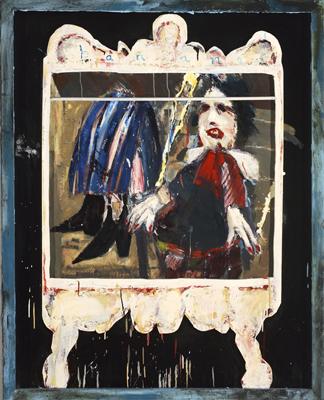
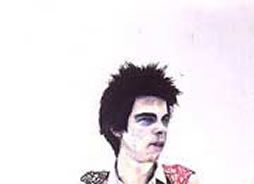

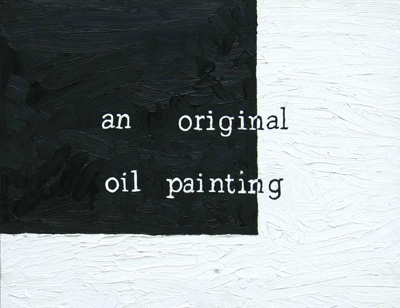
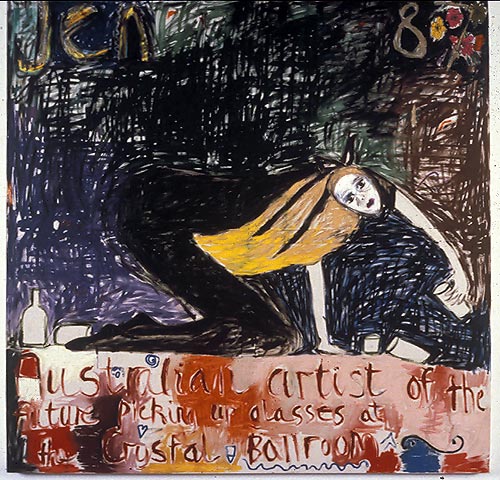

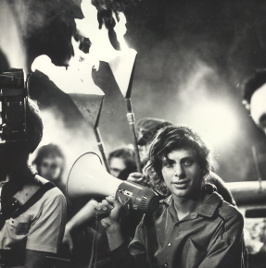

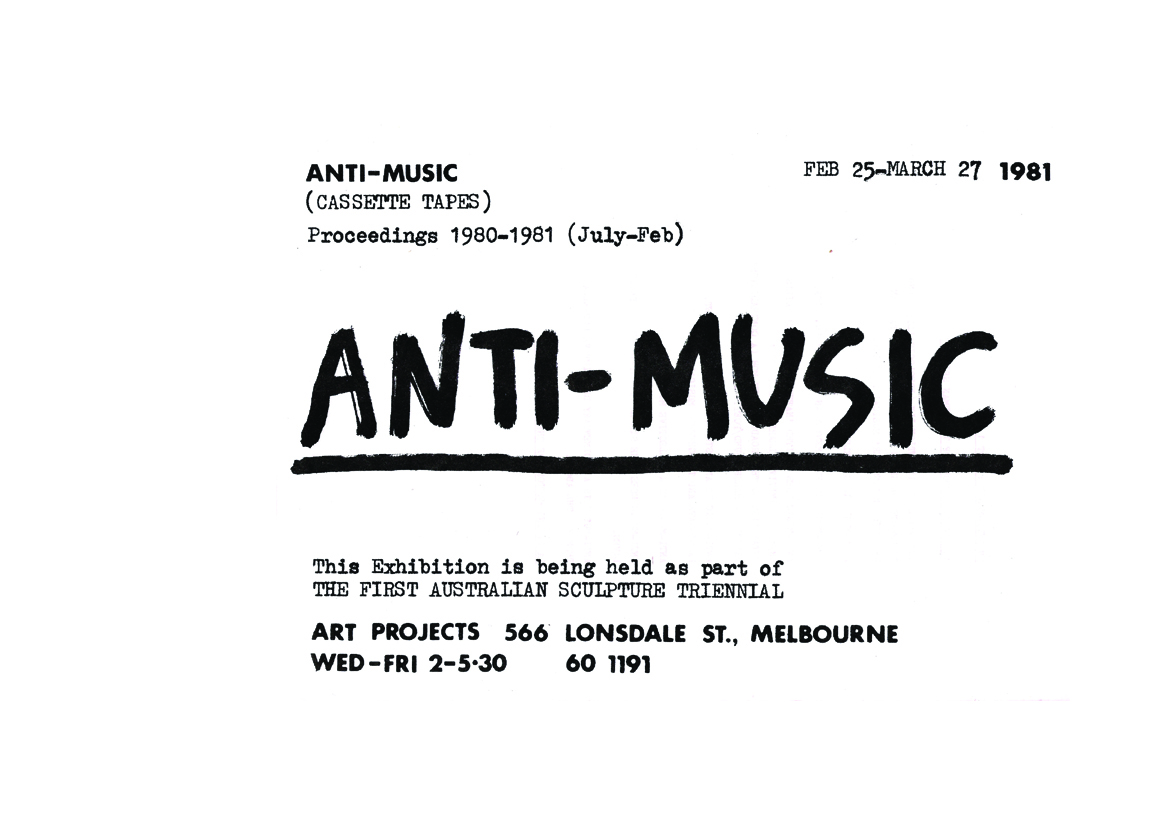
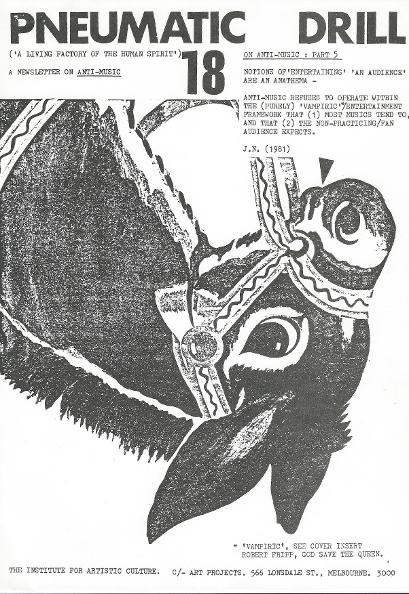
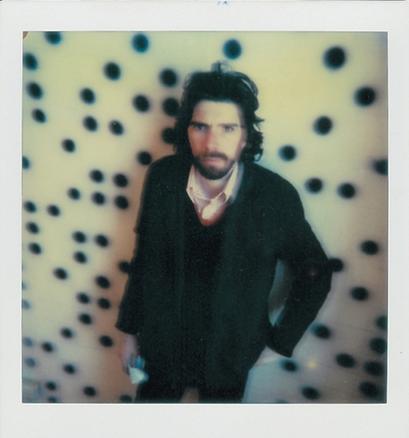

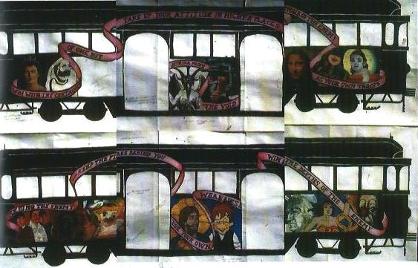
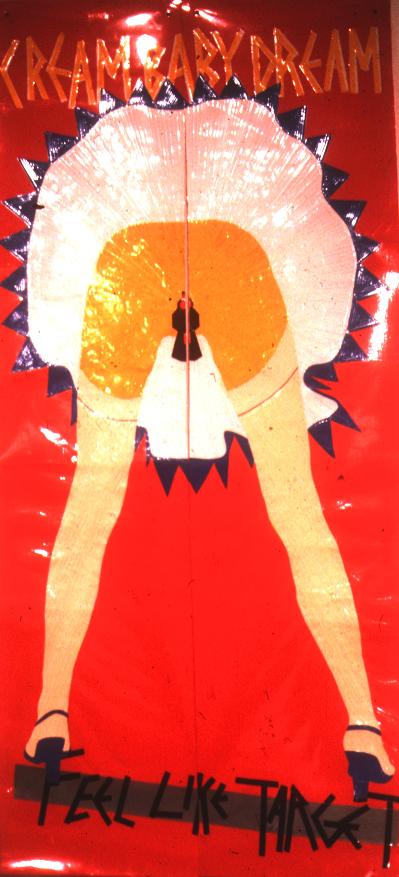
Feel like Target, 1980 by Gary Willis - Source: Gary Willis
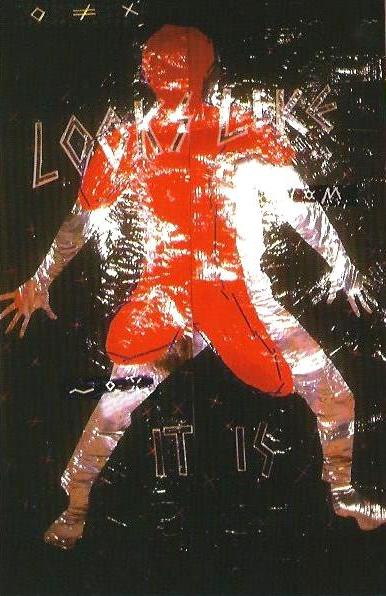

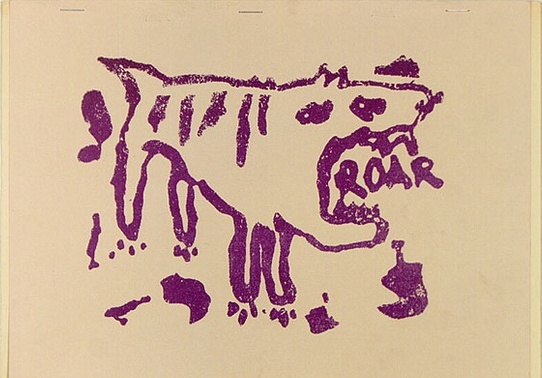

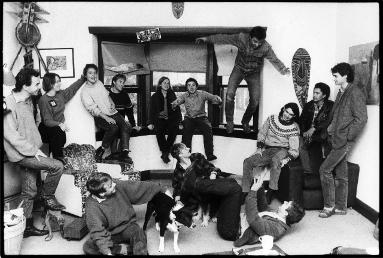

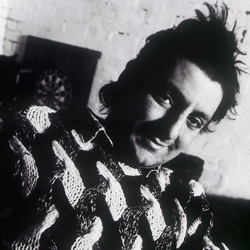
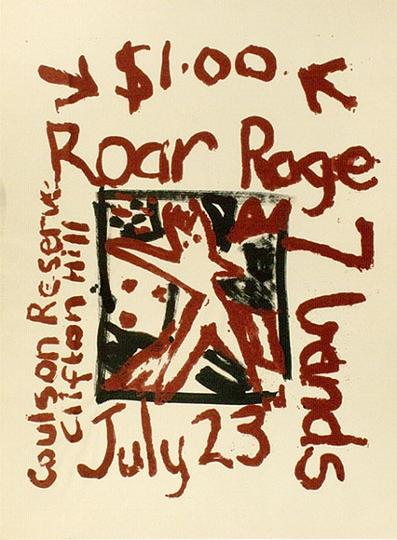
Punk as Art:
Organised in 1984 by Les Futo and Gillian Farrow, at the Warr Park Hall in Brunswick, was The Punk Exhibition of Expression as part of the annual Fringe Festival. A virtual "paucity of provocative punk painting", the exhibition was created to promote the view that the punk ethos and lifestyle is a living expression of art.
Presenting the underlying values and issues of anarchism, individualism, and animal liberation, while actively opposing sexism, racism and the nuclear threat, the artworks by Les and Steve Futo, Gillian Farrow, Mark Beaumont, Mullet, Bent Bill and Lisa, among others, proved that there was more to anarchy than just "people who hate the system".
"Each one of us will be exhibiting, expressing our feelings and ideas, as individuals on subjects that are normally hidden behind society's fast, non-caring lifestyle. Punk is not just people who like to dress offensively and not give a shit about our world!" (Steve Futo)
"The idea behind the exhibition was to educate people as to what the punk movement was about. We put in lots of protest posters people had drawn, silkscreens on t-shirts, pamphlets...I think most people were probably intrigued and definitely interested." (Gillian Farrow)
On a final note:
"...While many artists speak of punk nostalgically they are equally conscious that elements of the now taken for granted - the artists-run gallery or journal - exists as a direct result of punk's example." (Chris McAuliffe)
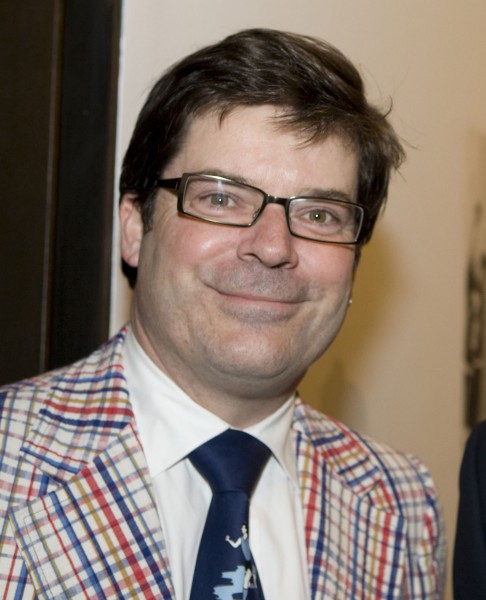
- Main Image - Primitive by Howard Arkley, 1981 - Source: Arkley Works
- Background Image - Portraits of Sam Sejavka and Christine Harding by Jenny Watson, 1981 - Source: Sails of Oblivion
- Jon Cattapan - Bananas, 1977 - Source: Expired
- Nick Cave by Jenny Watson 1977 - Source: Pinterest
- Jenny Watson by Robert Rooney 1979 - Source: Art Gallery NSW
- An Original Oil Painting by Jenny Watson, 1980 - Source: UniMelb
- Australian Artist of the Future Picking Up Glasses at the Crystal Ballroom by Jenny Watson, 1987 - Source: UniMelb
- Peter Tyndall, 1979 - Source: bLOGOS/Ha Ha
- Richard Lowenstein, 1979 - Source: Sense of Cinema
- Sex Pistols sticker, 1977 - Source: Sex Pistols
- Philip Brophy photo gallery - 1977 - 1987 - Sources: Philip Brophy, Discogs, Discogs, From the Archives and Fantastic Mess Records
- Anti-Music promo, 1981 - Source: Discipline, Issue 1
- Pneumatic Drill 18, 1981 - Source: Chris McAuliffe
- Howard Arkley, 1981 - Photo by John Nixon - Source: Art.Base
- A Fact is a Fact is a Fact, 1972 by Gary Willis - Source: Gary Willis
- Tattooed Arm Tram, 1978 by Gary Willis - Source: Gary Willis
- Feel like Target, 1980 by Gary Willis - Source: Gary Willis
- Looks Like - IT Is by Gary Willis, 1981 - Source: Gary Willis
- ROAR Studio building - 115A Brunswick Street, Fitzroy - Photo by John Corker - Source: Denise Morgan, (2011) ROAR
- ROAR Studios logo 1982, designed by Mark Howson - Source: Prints and Printmaking
- ROAR Studios opening show 1982, designed by Mark Howson - Source: Prints and Printmaking
- Roar Group, 1983 - Photo by Martin Kantor - Source: Martin Kantor Archive
- The Lone Dog Ball, 1983, designed by Mark Howson - Source: Prints and Printmaking
- Pasquale Giardino c. 1982 - Source: Facebook
- ROAR Rage, 1983, designed by Mark Howson - Source: Prints and Printmaking
- The Punk Exhibition of Expression gallery, 1984 - Sources: Les Futo, Gillian Farrow, Liz Gash and The Good Weekend Article
- Dr. Chris McAuliffe - Source: ANU
- John Nixon as Curator and Publisher in the 1980s - by Francis Plagne - Source: Expired
- Allen, Traudi. (1995) ROAR, Craftsman House.
- McAuliffe, Chris. (1997) Let's Talk About Art: Art and Punk in Melbourne. Art and Australia, Vol 34 No 4.
- Morgan, Denise. (2011) ROAR RE-VIEWED 30 YEARS ON, Macmillan Art Publishing.
- Pons, Xavier. (2002) Departures: How Australia Reinvents Itself. Article by Chris McAuliffe titled Guerillas, Poseurs and Nomads: The Politics of the Avant-Garde in Art and Music, pp 192-201, Melbourne University Press.
- Preston, Edwina. (2002) Not just a Suburban Boy, Griffin Press.
- Willis, Gary. (2000) Diary of a Dead Beat Modern Art Type, Gulag Publishing.
- Art in the Age of Mechanical Reproduction program, 1982 - Source: Chris McAuliffe
- Peter Tyndall. Slave Guitars article - Source: SSEX 2012 (reprinted from Art and Text. Summer 1981).
- Maria Kozic - The → ↑ → Installation - Source: Tasmanian School of Art, 1983.
- → ↑ → & Beyond: Anticipating Distributed Aesthetics - Source: The Fibreculture Journal, 2005.
- Post Punk Graphics - The Displaced Present, Perfectly Placed - Source: Philip Brophy
- Disturbing the edges of what we call art: Tim Johnson and punk, 2009 - Source: Chris McAuliffe
- Trying to Live Now, Chronotopic Figures in Jenny Watson’s A Painted Page Series - Source: Contemporaneity
- ...And the Leopard looked like ME! by Gary Willis, 1981 - Source: Gary Willis
- Gary Willis Art Video archives - Source: AVAA
- 'Let's Talk About Art' - Recorded live in 1979 at the Crystal Ballroom (Cave)
- Chris McAuliffe - Source: McAuliffe, Chris (1997) Let's Talk About Art: Art and Punk in Melbourne. Art and Australia, Vol 34 No 4.
- Ashley Crawford - Source: Rowland S. Howard Outta The Black
- Philip Brophy - Source: Philip Brophy
- Francis Plagne - Source: Discipline, No. 1
- Gary Willis - Source: Willis, Gary (2000) Diary of a Dead Beat Modern Art Type, Gulag Publishing and Gary Willis
- Denise Morgan - Source: Morgan, Denise (2011) ROAR RE-VIEWED 30 YEARS ON, Macmillan Art Publishing.
- Roar Studios punk gig - Source: Pasquale Giardino, Personal interview
- Steve Futo - Source: Article titled Punk art imitates life by Damien Kingsbury - The Weekender, 1984
- Gillian Farrow - Source: Personal interview
- What is dadaism, dada art, or a dadaist? | Artland Magazine
- http://www.ngv.vic.gov.au/arkley/education/print_essays04.html
- http://nickcavefixes.wordpress.com/2010/01/25/boys-next-door-melbourne-punk-pics/
- http://www.fromthearchives.com/bnd/chronology.html
- https://library.unimelb.edu.au/southbank-library/collections/special-collections/special-coll-folder/art150/about2/articles/artist-jenny-watson-in-her-own-words
- https://www.mca.com.au/artists-works/works/1995.261A-B/
- http://www.artabase.net/exhibition/2008-melbourne-brisbane-punk-art-and-after
- http://www.davidpestorius.com/exhibition.html
- https://slavepianos.org/
- bLOGOS/HA HA (blogos-haha.blogspot.com)
- https://buxtoncontemporary.com/peter-tyndall-listen/
- http://rowland-s-howard.com/articles/2009-melbourne-film-festival.php
- https://en.wikipedia.org/wiki/Philip_Brophy
- http://www.philipbrophy.com
- http://slavepianos.org/?category=archival
- http://www.artcollector.net.au/CollectorsDossierJonCattapansLocaltruths
- http://www.videoartchive.org.au/eschrammgwillis/titles.html
- https://www.arkleyworks.com/
- https://art.base.co/event/2008-melbourne-brisbane-punk-art-and-after
- https://www.artlink.com.au/articles/3470/melbourne-brisbane-punk-art-and-after/
- https://www.smh.com.au/culture/art-and-design/a-profound-loss-artist-john-nixon-dies
- https://artandcollectors.com/pages/rebel-rebel-roar-studios
- https://artandcollectors.com/collections/roar-artists
- http://www.smh.com.au/national/melbourne-life/artists-reunite-from-roaring-80s-20110222-1b42s.html
- http://en.wikipedia.org/wiki/Dada
- http://ashleighberryman.wordpress.com/2010/11/04/punk-is-dadaism/
- http://www.emelbourne.net.au/biogs/EM01256b.htm
- https://www.heide.com.au/exhibitions/jenny-watson-fabric-fantasy
- https://soundcloud.com/heide-moma/art-talk-urban-territories
